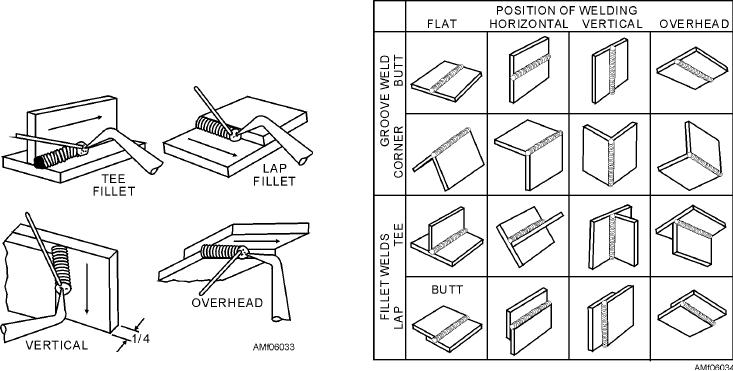
because the increased heat generated in this method is
puddle. This method is used in welding most of the
likely to cause overheating and burning. When welding
lighter tubing and sheet metals up to 1/8 inch thick
steel with a backhand technique and a reducing flame,
because it permits better control of a small puddle and
the absorption of carbon by a thin surface layer of metal
results in a smoother weld. The forehand technique is
reduces the melting point of the steel. This speeds up
not the best method for welding heavy metals.
the welding operation.
BACKHAND WELDING.--In this method the
WELDING POSITIONS.--The four basic
torch tip precedes the rod in the direction of welding,
welding positions are shown in figure 6-34. Also shown
and the flame is pointed back at the molten puddle and
are four commonly used joints. Notice that the corner
the completed weld. The end of the rod is placed
joint and butt joint are classified as groove welds, while
between the torch tip and the molten puddle. The
welding tip should make an angle of about 45 to 60
the tee and lap joints are classified as fillet welds.
with the plates or joint being welded (fig. 6-33).
Welding is always done in the flat position when-
ever possible. The puddle is much easier to control, and
Less motion is required in the backhand method
the welder can work longer periods without tiring.
than in the forehand method. If you use a straight
Quite often it is necessary to weld in the overhead,
welding rod, it should be rotated so that the end will roll
vertical, or horizontal position in equipment repair.
from side to side and melt off evenly. You may also
bend the rod and, when welding, move the rod and
The flat position is used when the material is to be
torch back and forth at a rapid rate. If you are making a
laid flat or almost flat and welded on the topside. The
large weld, you should move the rod so as to make
welding torch is pointed downward toward the work.
complete circles in the molten puddle. The torch is
This weld may be made by either the forehand or
moved back and forth across the weld while it is
backhand technique.
advanced slowly and uniformly in the direction of the
The overhead position is used when the material is
weld. You'll find the backhand method best for welding
to be welded on the underside, with the torch pointed
material more than 1/8 inch thick. You can use a
upward toward the work. In welding overhead, you can
narrower "V" at the joint than is possible in forehand
keep the puddle from sagging if you do not permit it to
welding. An included angle of 60 is a sufficient angle
get too large or assume the form of a large drop. The rod
of bevel to get a good joint. It doesn't take as much
is used to control the molten puddle. You should not
welding rod or puddling for the backhand method as it
permit the volume of flame to exceed that required to
does for the forehand method.
obtain a good fusion of the base metal with the filler
By using the backhand technique on heavier
rod. Less heat is required in an overhead weld because
material, it is possible to obtain increased welding
the heat naturally rises.
speeds, better control of the larger puddle, and more
complete fusion at the root of the weld. Further, by
using a reducing flame with the backhand technique, a
smaller amount of base metal is melted while welding a
joint. Backhand welding is seldom used on sheet metal
Figure 6-33.--Backhand welding.
Figure 6-34.--Four basic welding positions.
6-25

